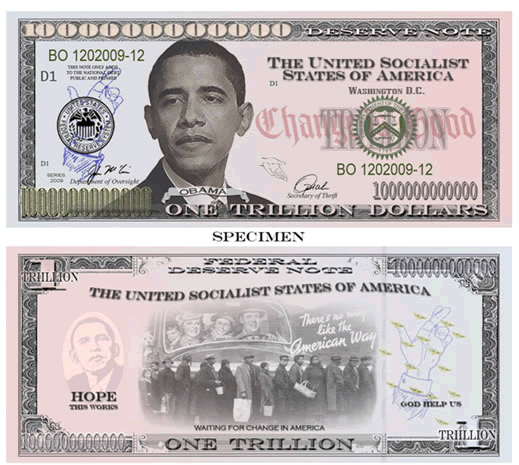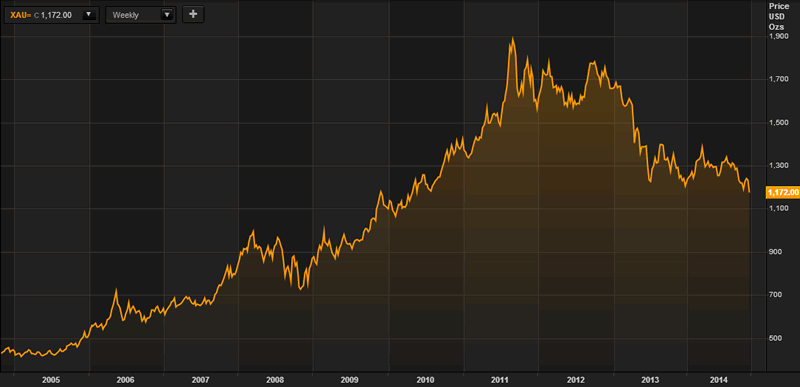Gold Price Falls, Stocks Record Highs as Japan Goes ‘Weimar’
Stock-Markets / Financial Markets 2014 Oct 31, 2014 - 03:23 PM GMTBy: GoldCore
 Stocks globally surged, while gold fell sharply today despite renewed irrational exuberance on hopes that the Bank of Japan’s vastly increasing money printing will fill some of the gaps left by the apparent end of Federal Reserve bond buying.
Stocks globally surged, while gold fell sharply today despite renewed irrational exuberance on hopes that the Bank of Japan’s vastly increasing money printing will fill some of the gaps left by the apparent end of Federal Reserve bond buying.

The BOJ decided to increase the pace at which it expands base money to a whopping 80 trillion yen ($726 billion) per year. Previously, the BOJ targeted an annual increase of 60 to 70 trillion yen.
The BOJ sailed into deeper uncharted monetary territory with the announcement that they would triple annual purchases of exchange-traded funds (ETFs) and Japanese real-estate investment trusts (REITS) to 3 trillion yen and 90 billion yen respectively.
The Nikkei surged 5% in minutes to a seven year high after the Bank of Japan decision, while gold fell.
These unprecedented monetary events remind us of the old English mapmakers who used to write on uncharted territories on their maps - “Here be Dragons”.
The BOJ claimed the surprise action was due to concerns that a decline in oil prices would weigh on consumer prices and delay a shift in sentiment away from deflation.
BOJ Governor Haruhiko Kuroda portrayed the decision as a preemptive strike to the ‘lost decade’ economy, rather than an admission that his plan to reflate the long moribund economy has so far failed.
The prime reason for the extraordinary monetary policies is likely that the Japanese economy remains very weak and risks tipping over into a depression. Bankruptcies more than doubled to 214 in the first nine months of 2014 compared with the same period a year ago.
Japan has introduced quantitative easing to stimulate the economy and to spur inflation. But it may backfire and lead to stagflation and in a worst case scenario a German ‘Weimar’ style hyperinflation.
The yen's real effective exchange rate has dropped to its lowest level since 1982. With Japan easing likely to deepen, the yen may fall to an unprecedented level. Though the fall of the yen may promote exports - energy, food and raw material costs will rise, especially imports.
There has been much cheer leading of the Fed’s announcement that QE is over this week. We have doubts whether this will be the case and believe that a new round of QE and deepening currency wars is inevitable.
The Fed is very unlikely to start actually withdrawing its stimulus, so its balance sheet will remain elevated and a source of risk. The Fed’s 6 years of QE saw its balance sheet soar to $4.5 trillion. As one monetary expert insider and expert put it to me in an email overnight:
“Just think, the Fed's balance sheet was $140 billion, comprised of short term T Bills, in 1980 and that was thought to be runaway expansionism.”
Most analysts are ignoring the fact that the Fed has leveraged itself to nearly 80 to 1 and is effectively insolvent. A mere 1.25% drop in the value of its assets will wipe out its capital base.
A few other inconvenient truths being ignored by markets and market participants for now are the fact that:
*The U.S. Total Debt to GDP ratio today is 340% and rising
*The U.S. National Debt continues to rise and will surpass $18 trillion in the coming weeks
*U.S. Unfunded Liabilities are estimated to be between $100 trillion and $200 trillion

One of the dire consequences that many of us warned would result from global currency debasement was the creation of new and large asset bubbles. This is coming to pass.
The other dire consequences that many of us saw flowing from QE and global currency debasement – a sharp fall in the value of fiat currencies and hyperinflation – have not come to pass.
However, history shows that stagflation and hyperinflation can be slow in developing but then can occur very rapidly.
Once the inflation genie is out of the bottle - it is nigh impossible to contain as was seen throughout the western world in the stagflation of the 1970s and has been in inflationary events throughout history.
Given the current weakness what should gold owners do?
Gold, in the short term, looks prone to further weakness. We could see gold test lows of $1,156 which is a 61.8% retracement of the move from the October 2008 low to the all-time high at $1,921. If clients are worried about their gold position and have short term commitments there are a number of ways to manage downside risk, which may be of interest, please call our office to discuss further..
See Essential Guide to Storing Gold and Silver In Switzerland here
MARKET UPDATE
Today’s AM fix was USD 1,173.25, EUR 933.45 and GBP 733.47 per ounce.
Yesterday’s AM fix was USD 1,205.75, EUR 958.09 and GBP 753.59 per ounce.
Gold fell $12.50 or 1.03% to $1,198.90 per ounce yesterday and silver slid $0.58 or 3.4% to $16.49 per ounce.
Bullion for immediate delivery lost as much as 2.6% to $1,167.49, the lowest since July 2010 and looked vulnerable to further falls to $1,100/oz.
Gold in U.S. Dollars - 5 Days (Thomson Reuters)

Silver slid as much as 3% to $16.00 an ounce, the lowest since February 2010. Platinum fell 0.9% to $1,239.75 an ounce. Interestingly, palladium bucked the trend and rose 0.5% to $790 an ounce, after a six days of gains.
Gold fell below $1,200 an ounce as equities and bonds surged - even bonds from Italy to Portugal climbed.
Gold in U.S. Dollars - 10 Years (Thomson Reuters)

Gold is heading for a decline of 4.4% this week, the most since September 2013. The metal is also set for the first consecutive monthly loss in 2014.
Silver is set for a fourth monthly decline that’s the worst run since June 2013. An ounce of gold bought as much as 73.3154 ounces of silver today, the most since April 2009.
If the mooted end of QE in the U.S. is bearish for gold and silver, then it is also equally bearish if not more so for overvalued stock and bond markets. Yet, those markets saw far less volatile trading and many stock markets are back at multi month highs or indeed all time record highs.
The sharp move lower today took place in illiquid Asian markets, soon after the BOJ announcement of the extraordinary new money printing experiment in Japan. This news in itself should have seen gold bounce higher as it is very gold bullish. Instead, gold plummeted lower.
The move lower this week also took place against a backdrop of very high global coin and bar demand in recent weeks which would ordinarily have led to higher prices. It also comes at a time of heightened geopolitical and economic concerns and the emergence of the Ebola virus. Not to mention, the bullish “Save Our Swiss Gold” initiative which will continue for the next four weeks.
As we wrote yesterday, the sudden sharp selling of precious metals this week despite robust demand could be another example of manipulation. Central banks want equities and bonds higher and precious metals lower. The counter intuitive trading action has hallmarks of continuing manipulation of the gold and silver futures market.
Prudent money will continue to dollar cost average into coins and bars on price weakness.
This update can be found on the GoldCore blog here.
Yours sincerely,
Mark O'Byrne
Exective Director
IRL |
UK |
IRL +353 (0)1 632 5010 |
WINNERS MoneyMate and Investor Magazine Financial Analysts 2006
Disclaimer: The information in this document has been obtained from sources, which we believe to be reliable. We cannot guarantee its accuracy or completeness. It does not constitute a solicitation for the purchase or sale of any investment. Any person acting on the information contained in this document does so at their own risk. Recommendations in this document may not be suitable for all investors. Individual circumstances should be considered before a decision to invest is taken. Investors should note the following: Past experience is not necessarily a guide to future performance. The value of investments may fall or rise against investors' interests. Income levels from investments may fluctuate. Changes in exchange rates may have an adverse effect on the value of, or income from, investments denominated in foreign currencies. GoldCore Limited, trading as GoldCore is a Multi-Agency Intermediary regulated by the Irish Financial Regulator.
GoldCore is committed to complying with the requirements of the Data Protection Act. This means that in the provision of our services, appropriate personal information is processed and kept securely. It also means that we will never sell your details to a third party. The information you provide will remain confidential and may be used for the provision of related services. Such information may be disclosed in confidence to agents or service providers, regulatory bodies and group companies. You have the right to ask for a copy of certain information held by us in our records in return for payment of a small fee. You also have the right to require us to correct any inaccuracies in your information. The details you are being asked to supply may be used to provide you with information about other products and services either from GoldCore or other group companies or to provide services which any member of the group has arranged for you with a third party. If you do not wish to receive such contact, please write to the Marketing Manager GoldCore, 63 Fitzwilliam Square, Dublin 2 marking the envelope 'data protection'
GoldCore Archive |
© 2005-2022 http://www.MarketOracle.co.uk - The Market Oracle is a FREE Daily Financial Markets Analysis & Forecasting online publication.



